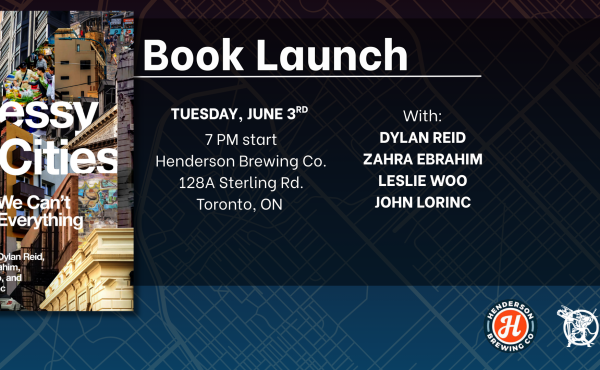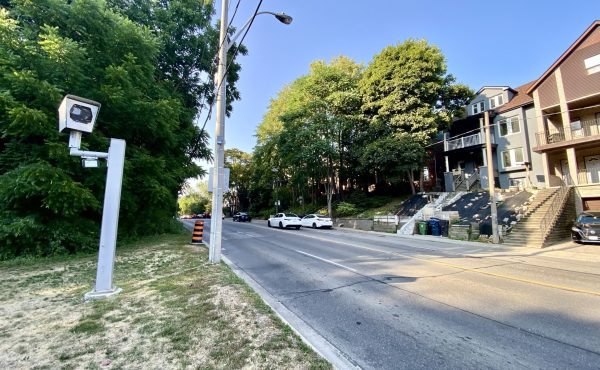
The National Post ran a little article about highway congestion. I’d be interested to hear readers’ thoughts on this idea.
GTA highways are maxed-out, but that does not mean commuters must accept traffic jams as a way of life. Professor Baher Abdulhai, director of the Intelligent Transportation Systems Centre at the University of Toronto, believes ramp meters or traffic lights at highway entry points would help ease GTA congestion by 10% to 30%. “The myth is this is penalty. It’s actually helping because you choose either to wait [at the light] for three or four minutes and finish your trip in 20 minutes. Or, allow [all vehicles] in, it’s going to break down anyway. Drivers will wait five-10 minutes creeping, and then spend an hour on the freeway.” Further investment in technologies on GTA highways is also advantageous, he says, allowing for improved traffic management, traveller information and incident detection. In the absence of such an investment, Mr. Abdulhai reminds drivers: “Manners help.”




8 comments
Drivers are all about short term gain and no pain.
They would go crazy waiting at a light — even it if would make for better flow.
I had professor Abdulhai last semester and I know that a short 10 minute talk by him, about advantages of the system would have anyone driver convinced. The problem is that the idea of traffic lights for highway ramps is unheard of to most people, while ramp metering is utilized in many places such as LA and Phoenix.
I must ad that unless implanted throughout the whole highway system, it could prove to be a disaster. The key is for all traffic lights along say 401 from west of Mississauga, to east of Whitby, to be connected to a central information and command system in such a way that every driver waiting at a traffic light of a ramp anywhere along the stretch of the highway gets the same share of waiting time. If the traffic light system is not centralized, the highway fills up at the beginning, and it leaves no room for new vehicles to move in, no matter how long they wait.
Maybe I misunderstand, but I can’t see how this would help. The image I get is cars and trucks backed-up and belching spew on city streets while waiting to enter the highway. I’d rather they were backed-up and belching spew on the highway, further away from me.
It may be hard to believe, but this could be a “win-win” for a number of reasons. Basic traffic flow theory: as traffic volume on a highway surpasses capacity, traffic flow breaks down, greatly reducing actual capacity when you need it the most. Regulating traffic flow on the ramps could help to avoid breakdown, especially because it deals with a common traffic phenomenon: vehicles tend to arrive in random clumps, or even worse, in regular platoons (e.g., because of a intersection with a traffic signal just before the ramp). Unregulated, those clumps of vehicles all squeeze on the highway at once, creating the starting point for major congestion. Ramp metering usually lets through one vehicle at a time, with very short red & green phases creating gaps between vehicles, which are more easily absorbed on the highway.
This isn’t totally new: it has already been used on a number of on-ramps to the QEW (but I’m not sure if it’s currently still active). Compliance wasn’t bad, and it shouldn’t be hard to apply the existing red light camera enforcement program to such ramp metering signals. However, the QEW implementation probably doesn’t include enough ramps for the desired, equitable “system effect.” And the algorithms used are a few years old – probably no longer the best.
Some Spacing readers may ask: rather than congestion on the highway, would there be long lines at the on-ramps, backing onto city streets? And will those queues push more drivers to detour via city streets, also having more impact on pedestrians, bikes & transit? Answer: it depends on the details of the algorithm, but if well implemented, better flow on the highway should minimize the amount of queuing before the highway, and reduce the need for drivers to divert to local roads. Remember, in the end this will let more vehicles onto the highway. W/o flow regulation, you have traffic breakdown, queuing and re-routing of traffic much earlier. (After all, drivers already react to 680 News or their experience, and detour via local roads all the time.)
Also, the resulting traffic on the highway will be smoother, avoiding extra pollution associated with idling and stop & go traffic on the highway. (Belching exhaust, smog & ground-level ozone travel far!)
Even if this helps, there are still capacity limits, and they would likely be reached on many GTA highways. How about combining ramp-metering with park & ride lots and bus stops next to surburban on-ramps? HOV’s & busses then bypass the ramp signal and connect to combo HOV/bus lanes on the highways. The queue of vehicles waiting to get on the highway could be a great advertisement for HOV and transit! (Note: traffic on the highway at maximum flow & capacity will be rather slow, although still moving. Special lanes could still offer higher speeds for HOV and bus.)
The devil would be in the details: in addition to having good algorithms, you need extensive coverage for a good implementation, as well as high-quality information from vehicle sensors (loops) in the road surface. Those loops already exist, but you may need more, and they need to be better maintained than is occasionally the case nowadays. Also, you need some space for cars to wait on the on-ramps, while leaving enough room after the signal so cars can accelerate to highway speed… and a good location for the ramp metering signal so it is visible, even on a curved ramp. However, plenty of other regions around the world have already implemented this, so we should be able to learn where and how this can be implemented.
Although much cheaper than building more roads, all this still costs some money. Park & ride lots, new transit service and HOV/bus lanes would add more costs. Finally, it all makes most sense as part of a larger system of major transit improvements, more high-tech for both transit & roads, and coordinated land-use planning. But if other cities can implement all these things, why can’t we???? The costs are minimal compared with the costs of excessive congestion, pollution, etc…
Thanks for the comprehensive info, Sam.
Would the system work in partial implementation, say, in a series of ramps along a stretch of highway that typically cause pockets of congestion? If so, it might be a way we can address our most immediate problem areas, introduce drivers to the system by region (quote Mr. Abdulhai on the pamphlet?), and split the project into phases.
Not sure, pockets might help too, depending on the relative flow on the highway & ramps. However, it may not be fair. You can’t regulate traffic once it’s on the highway. If the flow is too heavy before it reaches the metered ramps, the cars at those ramps are squeezed out to the benefit of the longer trips (as Sheyda mentioned). In some spots that may be desirable, like if you want to discourage short trips from using the highway, or if there’s better transit service there. But you’re sure to hear more grumbling from those drivers. Politically it’s easier to implement if you can say “it’s better for everyone.” BTW, nothing stopping you from implementing all this in conjunction with road tolls, except perhaps political reality.
Yeah, like you said earlier, it would depend on the effectiveness of the algorithms to make it worth the waiting time. The pocket plan would require extra research and math work to ensure even flow. We should at least do a consultation of our highway systems to measure feasibility, right?
Politically, there is an exciting potential to spin this so that both drivers and anti-drivers get what they want (less highway travel time and environmental benefits).
I’ve seen this in action in Minneapolis. Ramp metering involves, as one said, a traffic light at the beginning of an on-ramp cycling between red and green every five seconds.
I can’t tell you how effective this was, but I can see the theory. Certainly, where you see some slowdowns on the highway is as drivers approach on-ramps. The cars coming in as a block, slower than the normal traffic, slow the right lane and force cars onto the centre lanes. If these cars were spaced out a bit, the highway could accept them better, without a slowdown.